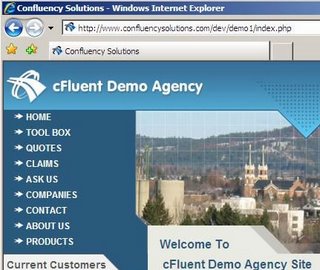Website Relevance, Big and Small :: Part II
Act cFluent Newsletter, October, 2006 - Subscribe today Subscriber benefits include early evaluation of new products and discounts. - Tell a friend
Information for independent insurance agents about issues at the confluence of technology, consumerism, marketing and agency practices. Subscriber benefits include free trial evaluation of new products and programs.
- Once you have an agency website with all the tools you need what do you do to make it pay off? Read the second installment in a multi-part series on making your website relevant and learn how to get more out of your advertising programs: Ecommerce Gives Traditional Advertising a Boost
- Are you doing all you need to do to keep customer information safe and secure. If you accept quote, policy change or other information via forms on your website you may be exposing sensitive information to theft. Read More
- Getting customers and others to use your website doesn’t require a sea change in habits. Ten Second Tips, a new feature of the Act cFluent Newsletter brings you ideas you can use right away to get more visits to your website, save your staff time and set your agency apart from the competition. We kick things off with nine tips Ten Second Tips
- View an example of a print advertising and landing page
- Need a few tools to beef up your website? Check out the plug-n-play cFluent Web Modules.
Part II of a multi-part series (Part One) that explores what you can do to make your website relevant to your agency, your employees, your customers and your prospective customers. These articles focus on agency strategies and initiatives apart from the internet and then suggest ways to make your website tools pay off in the context of those initiatives.
Nearly all of us have dabbled in traditional advertising, be it print, radio, television, billboards or mailings. You may not realize it but your website gives you a way to better measure the effectiveness of those traditional  campaigns. At the same time you can extend the breadth of the brand you are promoting. More importantly, your website gives you the opportunity to turn what is typically an exercise in creating awareness into the beginning of an ongoing relationship. The path along which a consumer becomes a customer begins with awareness. But a value added relationship with a consumer is necessary before a consumer is converted to a customer. An ad campaign that culminates with a relationship pays off in new business much more quickly. And that is why your website needs to be relevant to your advertising campaign.
campaigns. At the same time you can extend the breadth of the brand you are promoting. More importantly, your website gives you the opportunity to turn what is typically an exercise in creating awareness into the beginning of an ongoing relationship. The path along which a consumer becomes a customer begins with awareness. But a value added relationship with a consumer is necessary before a consumer is converted to a customer. An ad campaign that culminates with a relationship pays off in new business much more quickly. And that is why your website needs to be relevant to your advertising campaign.
The dot com days are barely visible in the rear view mirror now, covered in road dust. By now we have all learned to ‘promote our website’ at every free opportunity. That includes the traditional media ads that include the obligatory “…or visit our website at www.websitename.com” That’s old dot com thinking which doesn’t really leverage the valuable resource that is your website. The new marketing reality, where the internet and traditional communication mediums complement and support each other, might lead us to create a ‘landing page’ specifically for a unique ad campaign.
‘Landing page’ is a term most often used in connection with online advertising. It is the name for the page a web surfer ‘lands’ on when they click on an advertisement. Since consumers can’t click on a magazine or television ad you can’t really use a landing page, at least not in the strict sense of the term. What you can do is create a separate web page for a traditional ad campaign and organize information and online resources on that page that are relevant to the offline ad campaign. The special page link should be prominently displayed on the agency home page and should include the same graphic used in the offline ad. Your ad tag line should direct listeners/readers to this page; e.g., “…be sure to take advantage of promotional resources available at the
For instance, suppose you are running an ad campaign designed to highlight the choice and customization an independent can bring to bear in designing an insurance program for a consumer’s unique and evolving needs. A landing page for an ad campaign like that could include articles and checklists that would illustrate how varied risk exposures can be different from individual to individual or business to business. Interactive wizards, review tools or calculators that help a consumer gain a grasp of their singular risk needs can be very effective. You might also provide information about your agency that expands the message of the ad campaign such as your process for evaluating and updating insurance programs, the number of companies you represent (choice); you might also highlight unique products or coverage available through one or more of your companies. (And of course you should include links for quote requests).
Measuring clicks to this special landing page will give you a good idea of your ad’s effectiveness. But arranging pages in this way also gives you the advantage of delivering value to a consumer and forming a relationship. You are providing a test drive of your agency. This is important because, without constant ads or other reinforcement, only a minority of those hearing or seeing your ad will recall your agency within just a few months.
If you have an online newsletter, review program or other service that allows you to continue to communicate with a prospective customer you will be able to strengthen and expand the relationship you have begun thanks to your ecommerce boosted ad. Only about 20% of any pool of prospects will be interested in switching their insurance at any given time. But you will have established a value-added relationship, possibly a stronger one than the prospect has with their current agent, and that will give you an advantage when the quote opportunity does present itself – your agency will be top of mind. And that is the most important objective of a blended online/offline advertising campaign: creating a relationship with a pool of near and long term future customers, not just creating awareness.
View an example of a print advertising and landing page
Are you doing all you should be to protect your customer’s information and your agency from potential litigation? We’re not lawyers and even they differ in how they view the application of privacy legislation, like Gramm-Leach-Bliley, to the business practices of independent insurance agents. But one thing is certain: your agency is less vulnerable to bad PR and litigation if it is doing something to protect customer information.
You may be using your website or email to fulfill the Trusted Choice pledge of 24/7 service, meet the expectations of today’s consumers or just to cut down on costs. News stories about data breaches show up with regularity and heighten consumer sensitivity to the vulnerability of their information. Inevitably, one of your customers will ask you if information they share with you via your website is secure. There are a few things you should know before the question arises.
Email is not secure. Email is essentially an electronic postcard. And as with a postcard, anyone who comes into physical contact with information contained in the email can read it. Email passes from sender to  recipient over a series of servers, the path can vary depending on internet traffic, so you can never be sure which servers are on the communication path and who has access to it.
recipient over a series of servers, the path can vary depending on internet traffic, so you can never be sure which servers are on the communication path and who has access to it.
Quote, policy change and other forms on your website may pass information to your agency via email or maybe by directly updating a database. Unless that data is encrypted and the database server is secure the information passed from customer to your agency is vulnerable to interception. (You can usually tell if a form is protected by a secure server by looking for ‘https’ at the beginning of a web address or url in your browser address line vs. ‘http’).
A simple solution is to use a secure server for all online forms and discourage customers from using naked email for sending sensitive information to your agency. Servers can be secured by installing a certificate from Verisign or other provider. Once done you’ll be able to differentiate your agency from the competition by letting customers know that, not only do you provide legitimate 24/7 service, but you have also taken measures to protect their private information.
This new feature of the Act cFluent Newsletter brings you quick, simple ways to get more out of your website. Ten Second Tips brings you ideas you can use right away to get more visits to your website, save your staff time and set your agency apart from the competition. We kick things off with nine tips…
- Follow up on quotes, in person and preferably with a phone, call within one hour of receiving the request. Your conversion rate will increase dramatically. You don’t have to prepare a quote, just a follow up letting the prospect know you are working for them.
- The email leave behind – end a service call with an email including a link back to your website to content or resources relevant to the service or sales conversation. You get an email address and your customer starts using and referring your website. Costs go down, business goes up.
- Be prepared – and by that we mean ahead of time – to respond to internet requests in a variety of formats. Just because someone initiates a relationship through the internet doesn’t mean that a phone call or fax might not be the best next step.
- You’ve heard it before – never send out mail without a stuffer. In this case, pick a different resource on your website and use a monthly stuffer to draw attention to it.
- Don’t let your web policy change or quote forms be dumb ‘order takers’. Be sure to capitalize on opportunities to mention other products or coverage and offer to review your website user’s insurance program.
- Be specific. Calls to ‘check our website for valuable flood safety tips’ get a lot more response than a bland ‘be sure to visit our website’. Answer the question, ‘why should I?’ before it is asked.
- Make your staff aware of the content and resources at your website and help them use those resources to make their jobs easier and your customer’s experience richer. A regularly updated desk top reference is a good idea.
- Always include the 24/7 convenience and information on your website as part of your value proposition. Remember, value is an equation that is part price and part service. The stronger your service component, the less a factor is price.
- If you have a ‘welcome package’ for new customers, be sure to include a website orientation as part of it. Let them know what they can do on your website.


